Green architecture – Botanical Research Institute of Texas
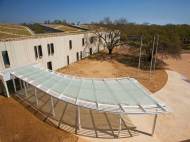 The Botanical Research Institute of Texas, Inc. (BRIT) has one of the largest herbarium collections in the United States. When BRIT decided to build their new herbarium and library building, they used careful site design, responsible landscape management, and conscientious human behavior, in order to reduce the footprint on the natural world as well as to protect and restore the local ecosystem.
The Botanical Research Institute of Texas, Inc. (BRIT) has one of the largest herbarium collections in the United States. When BRIT decided to build their new herbarium and library building, they used careful site design, responsible landscape management, and conscientious human behavior, in order to reduce the footprint on the natural world as well as to protect and restore the local ecosystem.
Designed by New York-based H3 Hardy Collaboration Architecture, an architecture firm, and Balmori Associates, a landscape architecture and urban design firm, BRIT’s new herbarium is a two-story, 1,860 square-meter (20,000-square-foot) climate-controlled building, with the remaining 165 square meters (5,000 square feet) for research and BRIT’s library.
Green Mountain Energy Solar at BRIT is a solar photovoltaic array on the herbarium roof that provides approximately 14% of the building’s electricity requirements. BRIT takes advantage of Earth’s constant temperature with 166 geothermal wells drilled beneath our parking lot and landscaping, thus cutting down the healing and cooling loads by more than 50%. The green roof is carpeted with plants that reduce cooling/heating needs as well as rainwater runoff. It also improves durability and provides a habitat for native plants, butterflies and birds.
Thanks to expansive windows, natural sunlight pours in through more than 75% of the building. Abundance of daylight cuts energy use and provides better-quality light. Fluorescent and LED lights are used for indoor lighting. In addition, the smart lighting with motion detectors and light harvesting sensors decreases lighting and energy consumption as the natural light in the room increases. Sunshades on the south, east and west elevations allow light into the building while reducing the amount of solar heat gain gathered through the windows.
The outside walls of the building are light colored so they reflect heat to reduce heat absorption. Plants on the living roof and outside walls shade the building, reducing the amount of heat generated by the sun that is absorbed by the building, thus reducing the demand on the AC system and making occupants and visitors outside of the building more comfortable by reducing heat that is absorbed and then radiated by the building.
Rain gardens are shallow depressions near runoff sources. Planted with deep-rooted native plants and grasses, they protect sewers from flooding, nourish indigenous plants and help reduce pollution and erosion. Native plants reduce maintenance costs and let watering to be natural instead the use of sprinkler systems. A retention pond stores stormwater runoff from the roof and parking area to a large tank. Although most of the site doesn’t need irrigation, this water is used for the small portion that does. Low-flow faucets, dual-flush toilets and waterless urinals reduce water use 60% over EPA standards.
Recycled-content materials were used for over 20% of BRIT’s building materials. The most significant recycled-content materials are structural steel, steel pipes and other metal products. Gypsum board and the acoustical ceiling panels are made from recycled sheetrock. The rubber-based floors are made from recycled tennis shoes and other rubbers, like tires and single-ply roofing membrane. They used both certified hardwood such as ash and recovered wood. The sinker cypress wall in the foyer comes from cypress logs that sank to the bottom of the river as they were being transported to market over 100 years ago. Once retrieved and dried, cypress wood looks beautiful. Wool carpet and bamboo ceilings are examples of rapidly renewable materials. They also use of linen and paper wallcoverings which reduce the need for non-renewable materials and increasing indoor air quality.
Low volatile organic compounds (VOC) carpets, floorings, and composite woods were selected to contribute to a healthy indoor environment. Instead of using standard insulating materials for the walls made with formaldehyde and fiberglass, BRIT’s wall insulation is made from sand and post-consumer recycled glass bottles, baked and blown like cotton candy.
Operations for the facility include provisions for the pick-up and processing of materials for recycling. The administrative areas and public spaces have recycling containers for paper, metals, glass and plastic.

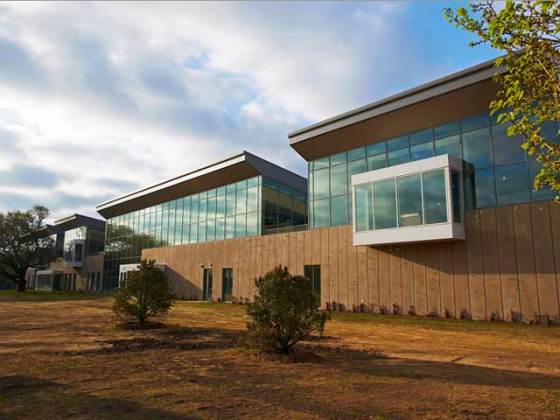
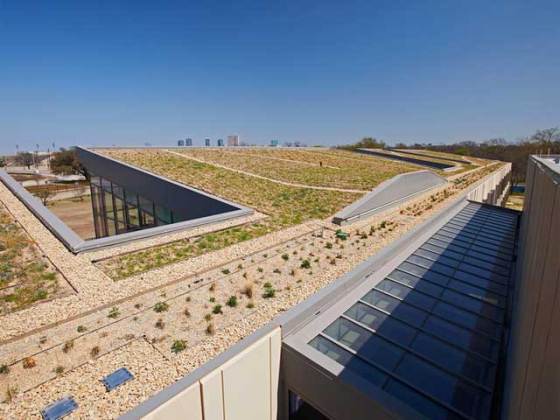
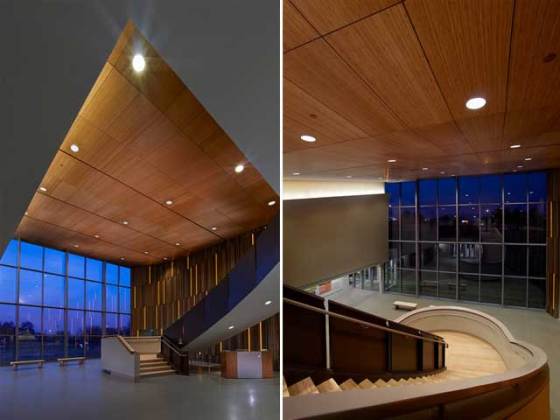
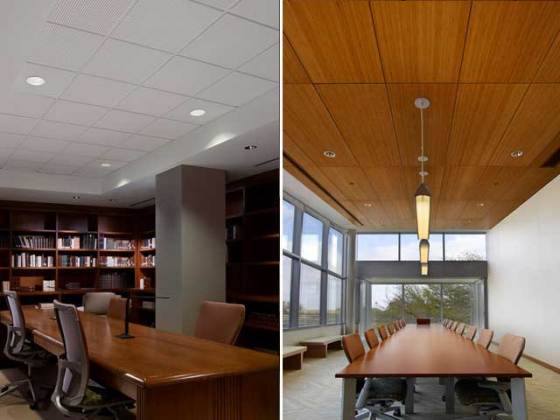








I guess these are all early images of the build because there’s not a lot of greenery around the building or on the “green” roof.
Aside that, the building seems very well lit and I like sustainable features, but it should be made in a way to be more practical without the waste of space.